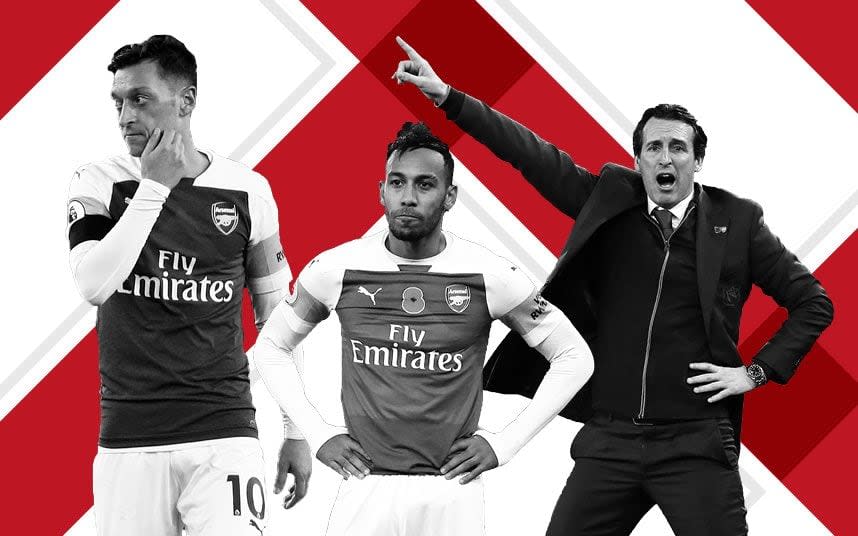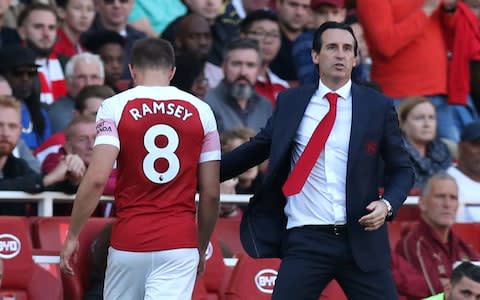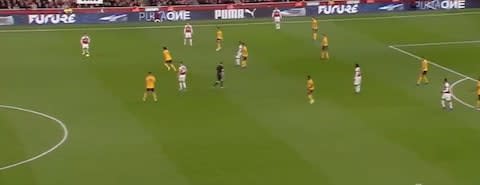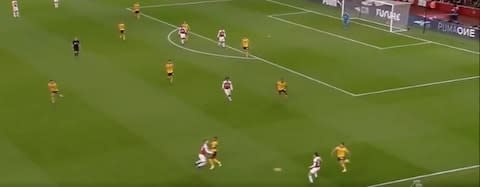Why are Arsenal starting games so slowly under Unai Emery?

Arsenal supporters have welcomed the nursery freshness of life under Unai Emery, but there is a creeping familiarity to their disjointed first-half performances this season.
Cardiff City are the only other team who have not led after 45 minutes of a Premier League game, with Arsenal reliant on stirring second halves, unerring finishing and fine goalkeeping to come to their rescue.
The trend has not been without its positive features: Emery's in-game management and Arsenal's endurance have impressed and won valuable points.
However, if Arsenal are to achieve their objective of Champions League qualification they will need to eradicate such unevenness and find a way to impose their style on opponents from kick-off.
Only at Chelsea and Fulham, and at home to Liverpool, has Emery's team come close to doing that, so what are the reasons for this mysterious flaw?
The tangibles
Unbalanced team selections
Emery's knowledge of Arsenal's squad and his analysis of individual players reportedly won him the job, but could not have fully prepared him for working with his new charges at close quarters.
With Emery still acquiring new information about his players, it is only fair to grant him some leeway as we stand in mid-November.
The Spaniard's proactive substitutions, such as hooking Mesut Ozil and Aaron Ramsey or moving Granit Xhaka to left-back while the game was level against Leicester, has put credit in the bank.
This touchline radicalism does have a more worrying implication, however - that Emery is struggling to select a balanced and suitable team to begin with, particularly in attack.
After two creditable but fruitless opening matches against Manchester City and Chelsea, he tried to crow-bar Ozil, Ramsey, Pierre-Emerick Aubameyang and Alexandre Lacazette into the same team. The quartet started Arsenal four consecutive victories over Cardiff, Newcastle, Everton and Watford in which Arsenal scored only one first-half goal. That was via Shkodran Mustafi from a corner at Cardiff.
Though Arsenal's most talented offensive line-up on paper, the presence of Ramsey and two strikers is problematic. Midfield players of Ramsey's ilk are at their most vital and effective in teams that play with a lone striker, where their penetrative runs are needed to provide extra goal threat and penalty box presence. Think Steven Gerrard behind Fernando Torres, Frank Lampard feeding off Didier Drogba or more recently, Dele Alli buzzing around Harry Kane.
Ramsey's best season at Arsenal was 2013-14, when the immobile Olivier Giroud lead the line alone, making the Welshman's dynamism indispensable. In the set-up Emery attempted earlier this season however, he saw his path into goalscoring positions occupied by two forwards. At times, Ramsey and Aubameyang would quite literally run into each other as they made identical movements. The result was two deep-lying midfielders, three goalscorers haring forward as soon as Arsenal regained possession, and Ozil occupying the chasm in between on his own.

The introduction of an additional playmaker in Alex Iwobi to play closer to Ozil was key to wins over Everton and Watford. Lucas Torreira's cameos from the bench were also a feature of those early wins. Arsenal's attack has functioned at its best with two creators (from Iwobi, Ozil and Henrikh Mkhitaryan) and two goalscorers (Lacazette, Aubameyang, Ramsey). In the first half against Leicester, the balanced tipped too far in favour of the former, with Lacazette isolated up front.
It seems Emery is learning this lesson: against Crystal Palace, Liverpool and Wolves, Arsenal started with the 2+2 formula of two creative players alongside Lacazette and Aubameyang, but that has not solved their trouble getting out of the traps.
Predictable patterns of play
Arsene Wenger's Arsenal were suspected of relying on improvisation and off-the-cuff solutions - football as 'jazz' as Philippe Auclair once described it - and Emery is clearly trying to imprint a stricter positional game.
Arsenal have been deliberate to the point of fastidiousness in their attempts to build play from the back, and Bernd Leno's belated promotion and Torreira becoming a fixture has helped considerably in this regard.
We are dealing with a small sample size, but it could be that these repetitive patterns are a source of comfort to Arsenal against 'Big Six' opponents but a slight hindrance against the rest. Like stabilisers on a bicycle, rigidity might be stopping Arsenal from falling flat on their face, but could also prevent them from racing towards the front of the pack.
Arsenal played out with admirable composure against Liverpool, but found it difficult to build through central areas against Crystal Palace and Wolves. An interesting difference between Arsenal's numbers in first and second halves is that in the opening period they play far more passes in their own half: 1,785 to 1,464 once they have opponents pushed back.
Emery's team have not diverted from a 'box' formation, evident below during the first-half at Palace when Arsenal had plenty of sterile possession. The 'box' is formed by the two central midfielders and the two centre-backs with both full-backs high and wide. This gives Arsenal better security than during the late-Wenger years should they lose the ball, but makes their passing options a little easy to read.
The receiving midfielder, in this case Torreira, can either go back to the defender, wide to the full-back or else try a very risky pass to Arsenal's forward's who are blocked by Palace's midfield.

Eventually, Torreira ends up passing back to Holding who returns the favour, before Torreira passes all the way across the back-line to Mustafi. Ozil drops deeper to resolve the problem and get Arsenal going, although this means he is receiving the ball in a less dangerous position.

Arsenal's problems progressing through the thirds has been a feature in other first-halves too. It is not too Anglo-Saxon to suggest a little more variety could be beneficial, at least to turn opposition defences around and gain a foothold early in matches, rather than making teams feel comfortable.
When learning a new skill, it is natural to verge towards an exaggerated and fundamentalist position, before it seeps into muscle memory. Perhaps when Arsenal are comfortable with this new foundation we shall see more intuition return to their play.
Energetic and clued-up opponents
Teams are at their physical optimum in the first half of matches, and the early stages are typically when the gameplan worked on all week is in its most perfect state. Injuries, red cards and the effect of goals can lay waste to best laid plans as the game goes on.
With a new manager for the first time in 22 years, Arsenal were an unknown quantity at the beginning of the campaign. Every Premier League club employs a forensic team of video analysts and number crunchers however, so it does not take long for the novelty factor to wear off.
One facet of Arsenal's play opponents are definitely starting to account for is how they combine with their full-backs - no Arsenal player has more Premier League assists than Hector Bellerin. Their best offensive performances have been based on getting Bellerin and Nacho Monreal or Sead Kolasinac to the bar-line through combination play with Arsenal's narrow 'wide' midfielders.
Although Palace played with a back four and Wolves a back five, both employed a narrow midfield that shifted across the pitch aggressively when Arsenal switched play to the flanks. Consequently, Arsenal struggled to find the bar-line with one-twos as they had done previously. Below are some notable examples from the 1-1 draw with Wolves.

In the above example, Matt Doherty is quickly out to engage Kolasinac, while Ryan Bennet is blocking the channel Iwobi would normally burst into for the return pass against a back four. There are three Wolves defenders between Kolasinac and Aubameyang, and the visitors outnumber Arsenal five to two in this situation. Kolasinac is forced to whip a cross in, which was deflected for a corner.
Arsenal would have hoped to isolate the wide centre-backs in Wolves' back three, but with a lead their rearguard became an obdurate five. Arsenal should have had a numerical advantage on the flanks, but with Iwobi and Aubameyang playing narrow, it left a simple one vs one of full-back against wing-back for Wolves to deal with.

Again above, Wolves' defensive 5-3-2 shape has shifted right across to the left to stifle Arsenal, who do the logical thing and try to switch play to the opposite flank. Mustafi is perhaps guilty of carrying the ball into Bellerin's space but once again Wolves wing-back Jonny is super aggressive and smothers Bellerin. It was a feature of the game, as Arsenal were forced into ever more confined spaces.

The lack of dribblers
As Arsenal's magnificent, back to front team goals against Fulham and Leicester showed, they have the pace and technical quality to sweep opponents aside with open ground in front of them. That space tends to be there in the second half when things become more open - their quickfire second goals against Everton and Watford also came from broken play.
In first halves however, defences are set for longer periods. There are four potential avenues to get around an organised defence: shots from distance, attacking crosses in the air, dribbling past someone to pull the defence out of shape or trying to pass your way through narrow lanes. The latter is the most difficult, but is the one Arsenal rely on due to their lack of dribblers or a true winger.

Aubameyang has impersonated one from the left, but is a centre-forward playing out of position. He is a clumsy dribbler and average linking play with his back to goal. The striker has scored seven Premier League goals, but four of those came from the bench in two games - one of the most prolific poachers in European football has actually only scored three in 10 league starts.
Iwobi offers some ball-carrying potential, but without the ability to burst through enemy lines Arsenal are forced to pursue a far more measured and slow-burning approach. Perhaps Reiss Nelson will fill the void when he returns from Hoffenheim.
The intangibles
Information overload
Several Arsenal players have commented on the increased tactical instruction under Emery and focus on the strengths and weaknesses of the opposition. This was music to the ears of Arsenal fans, who for years bemoaned the perceived lack of prescriptive coaching.
The players might welcome this deluge of information, but it is nevertheless a new part of their pre-match preparation. Under Wenger, they were encouraged to imposed their talents on the opposition from the off (although sleepy first halves of slow possession were not uncommon under the old regime either). Could it be that Arsenal now have a few too many thoughts and tactical considerations in their head? To borrow an expression from golf psychology, are they suffering from 'paralysis by analysis', before loosening up after half-time? We can only guess.
Lack of faith in defence
Despite Arsenal's reputation for second-half improvement, they have actually conceded more shots on goal after the break compared to first halves. Throwing caution to the wind clearly has attacking benefits - Arsenal have had 39 second-half shots on target to 22 in the first - but they are not gaining any more defensive security. In fact, as the dying embers against Wolves show, they are sacrificing some.
A lack of faith in the back four could be a factor in Arsenal's circumspect beginnings, symptomatic of a team reluctant to attack aggressively because they are worried about the counter-attack. Jose Mourinho has had this issue at Manchester United: protect the sub-standard defence and the attack stalls, attack with abandon and teams cut through the defence at will.
In crude terms, there are two ways to improve a defence: greater protection and organisation or buying better defenders. Torreira's presence in midfield offers more assurance, but Emery has not really done the former and has not had the funds to do the latter (yet). Arsenal push both full backs forward and play a high-line with two medium-paced centre backs, and they really need greater individual quality back there to get by like this, not to mention more pace. If Arsenal could trust their defenders to cope in isolation, they could play with greater freedom.
Should we expect any different?
Arsenal have produced a mixture of good, indifferent and poor performances, which is very much par for the course for a team trying to construct a new identity and culture under a coach who succeeds a legacy manager. Pep Guardiola, Jurgen Klopp and Mauricio Pochettino all suffered from inconsistency in their first seasons at other top six clubs. The early versions of their City, Liverpool and Spurs teams were capable of thrilling one minute, then shipping four at Leicester or three at Watford the next. Why should Arsenal be anything other than erratic at the same stage?
The positive is that while Emery still has many creases to iron out, Arsenal have managed to accumulate enough points to stay in touch. They will need more stability and faster starts if they want to stay in the hunt.

